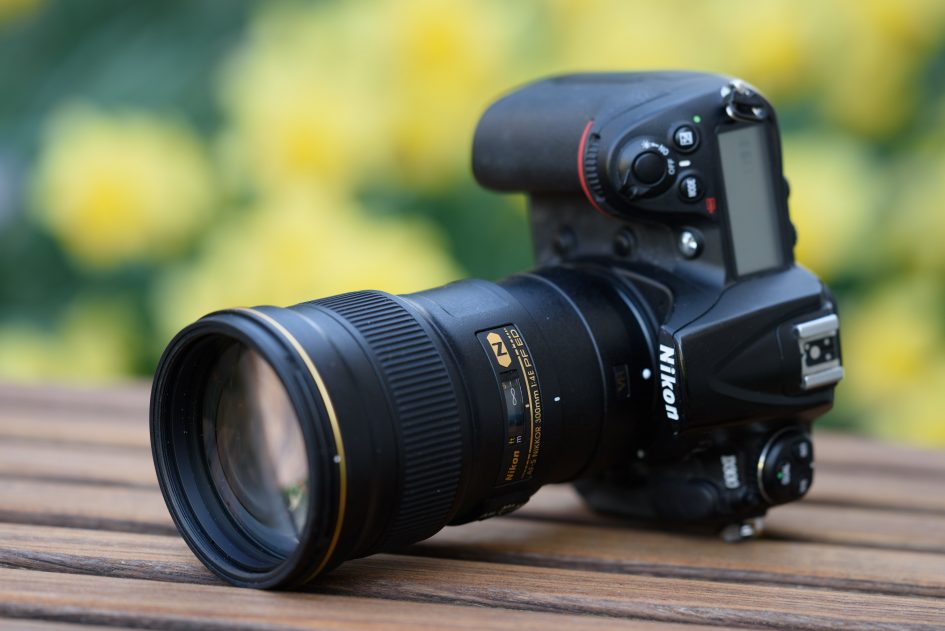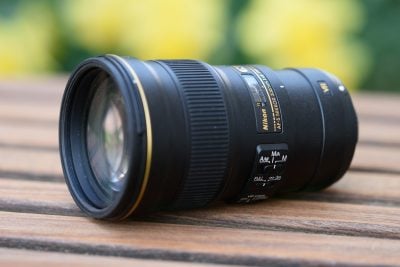Nikon 300mm f4E VR review
-
-
Written by Thomas
Verdict
The Nikon AF-S 300mm f4E PF ED VR delivers very good sharpness and overall contrast even wide open. And that in a package that is the smallest and lightest 300mm f4.0 lens available for full-frame cameras: indeed, it’s lighter and only a little longer than Nikon’s own standard 24-70mm f2.8G zoom! New technology like the Phase Fresnel element, the Fluorine coating of the front-lens, the electromagnetic aperture mechanism plus image stabilization that can get you sharp shots hand-held even down to at 1/20 sec add up to a very attractive package even considering the price of 2000 EUR (incl. 19% VAT) at the time of writing. Plus it goes down to 1:4 magnification, has fast AF, produces no longitudinal CAs, and works well with a 1.4x teleconverter.
But all is not roses: the Phase Fresnel element has its side-effects, the image stabilization (on my test copies) was very weak around 1/160 – 1/80 sec, and some are not content with its background Bokeh. Let’s start with the latter: there are some images on the Web that show some strangely sharp rendering in the background, something like ghostlike appearances of cars, people or twigs that should be so far out-of-focus that they should not be recognizable. I tried hard to reproduce this effect but couldn’t in over 800 test-shots. In general the background Bokeh at f4.0 is pretty smooth with no or little outlining. The are only a few instances which I remarked upon on my page of sample images where blurred background lights produce somewhat “scattered” Bokeh balls or unsharp subjects render in a counter-intuitive way. And its predecessor, the Nikon AF-S 300/4.0D, renders the background blur less smooth.

How about the Phase Fresnel element? Nikon did well to announce the risk that this element produces colored flare against strong contra-light. It does, and some of the effects look outright ugly. Plus: in all cases where I found the typical flare the new option in Capture NX-D to reduce Fresnel flare did not work very well – or to put it more bluntly, in many cases I had a hard time to find out whether it did anything at all. It worked better to simply desaturate the objectionable occurrences in post-processing and get rid of the blue and magenta colorations. But even then the flare was larger than the old 300/4.0D. So yes, the new lens has a very visible problem – but only under certain circumstances: The light-source has to be in the frame, very strong, and rendered sharp – like the sun reflecting head-on in the water. Stopping down does not eliminate the effect, indeed it can make it even stronger. But you have to keep it in perspective: “Normal” specular highlights like gilded subjects, love-locks, or droplets in the sun did not provoke the effect. I personally wouldn’t rate this a serious issue.
So last but not least there is the questionable performance of the VR. Let me sum this up again: At shutter speeds of at least 1/320 sec images shot hand-held with VR=ON were visibly sharper on the average than with VR=OFF. At shutter speeds of 1/40 sec or 1/20 sec images shot hand-held with VR=ON were almost as sharp as if shot at 1/320 sec with VR=OFF. This is a very good result. The problem is with shots in the range of 1/160 – 1/80 sec that (from my test copies) were on average less sharp than shots at 1/320 (with or without VR) or at 1/40 and 1/20 with VR. Comparing stabilized shots at 1/160 sec to shots hand-held with VR=OFF revealed that the chances to get a good sharp shot was better with VR=OFF than with VR=ON. But who would switch VR on or off depending on shutter-speeds? I shoot mostly in aperture priority with auto-ISO kicking in once the speed drops below a certain threshold. With a good working VR I set the threshold to 1/focal length minus 2 stops. With this lens I could only set it to 1/focal length – which is almost as if I had no VR at all. Although actually the VR is good for 3-4 stops at shutter speeds of 1/40 sec or longer.
As others on the web have reported similar findings the observed VR behaviour is not an individual problem with the two copies I tested. I hope Nikon does find a cure, because a good working image stabilization is a must have in my book for any lens longer than 135mm. This is also the reason why I can’t currently recommend this lens.
But let’s go through some of the alternatives and see how they compare.
Compared to Nikon AF-S 300/4.0D ED
 | ||
The old 300/4.0D is the predecessor of the 300/4.0E VR and it always had a good reputation for image quality if you were able to eliminate shake. Which was quite a challenge if you had to use the supplied tripod mounting, which was simply too flimsy to eliminate shutter-shock on even the sturdiest tripods.
In my tests I simply used electronic first curtain to eliminate this source of shake and got results that were only a little behind the 300/4.0E VR in optical performance. The 300/4.0D even has one optical benefit over the new model: it renders strong contra lights better as it does not suffer from Fresnel flare.
But other than that the old lens has clear disadvantages against the new 300/4.0E VR: it is 60% heavier and 50% longer than the new lens and it does not have image stabilization. If this doesn’t deter you (and you have a good solution to eliminate shake) then the current price of around 1300 EUR looks like a bargain against the new lens. Had I published a review of the Nikon 300/4.0D ED, it would have earned a recommendation from me.
Compared to Nikon AF-S 80-400/4.5-5.6G ED VR
 | ||
Nikon’s second edition of a stabilized 80-400mm zoom performs quite impressively. But it is much larger, much heavier, and only operates at f5.6 at 300mm. And it cannot compete on image quality at 300mm either. But a zoom is always more flexible and I find this especially important with tele-lenses: because it’s often not so easy to “zoom with your feet” if the crop from a fixed focal 300mm lens is not fitting.
The 300/4.0E VR is clearly the more specialized lens, so you have to ask yourself what your shooting situations call for .
See my Nikon 80-400mm f4.5-5.6G VR review for more details where this lens earned a Highly Recommended rating.
Compared to Nikon AF-S 70-200/2.8G ED VR II plus Nikon AF-S TC-14E III
 | ||
Nikon’s standard 70-200mm zoom has a constant f/2.8 aperture and can be converted with Nikon’s 1.4x teleconverter into a AF-S 100-280/4.0G ED VR.
As such it almost reaches the specs of the 300/4.0E VR at the long end, offering the wider f/4.0 aperture over the 80-400mm zoom. But again: the combo is much larger, much heavier, and more costly. And the image quality at 280mm is clearly behind the 300/4.0E VR. The 2.8x zoom-range offers less flexibility than the 5x zoom-range from the 80-400 – but it still is a lot more flexible than the fixed focal 300/4.0E VR. Again, it’s your choice whether you prefer a smaller, lighter package with superior image quality over the flexibility of a zoom.
See my Nikon 70-200mm f2.8G VR II review for more details where this lens earned a Highly Recommended rating.
Nikon AF-S 300mm f4.0E PF ED VR final thoughts
The AF-S 300mm f4E is the sharpest, lightest and smallest 300mm f/4.0 lens you can get for your Nikon DSLR. I couldn’t find fault with the background Bokeh and the Fresnel flare is limited to very specific shooting situations which wouldn’t hold me back from awarding it a “Highly Recommended”.
But tough luck: the VR has great potential but didn’t deliver in a critical range of shutter-speeds around 1/160 – 1/80 sec on my test copies of the lens. Sure: you can switch the VR off but then you’re paying top dollars for a lens where one of the major features is not properly working. I simply can’t recommend that.
Let’s hope that the VR problem is a bug that can be eliminated by a revision of the VR module or the firmware and not a feature that stays permanently with this otherwise excellent lens. It’s a pity, but until a revised model arrives which addresses the VR issues I experienced, I currently cannot recommend this lens.
Good points
Excellent image quality across a 36MP full-frame sensor even wide open.
Smallest and lightest full-frame 300/4.0 lens.
Excellent image stabilization at low speeds.
Weather sealing at the lens-mount.
Quiet and fast AF operation.
Maximum magnification of 1:4.
Bad points
VR not working properly around 1/160 – 1/80 on the samples I tested.
Fresnel flare under extreme conditions.
Expensive.




